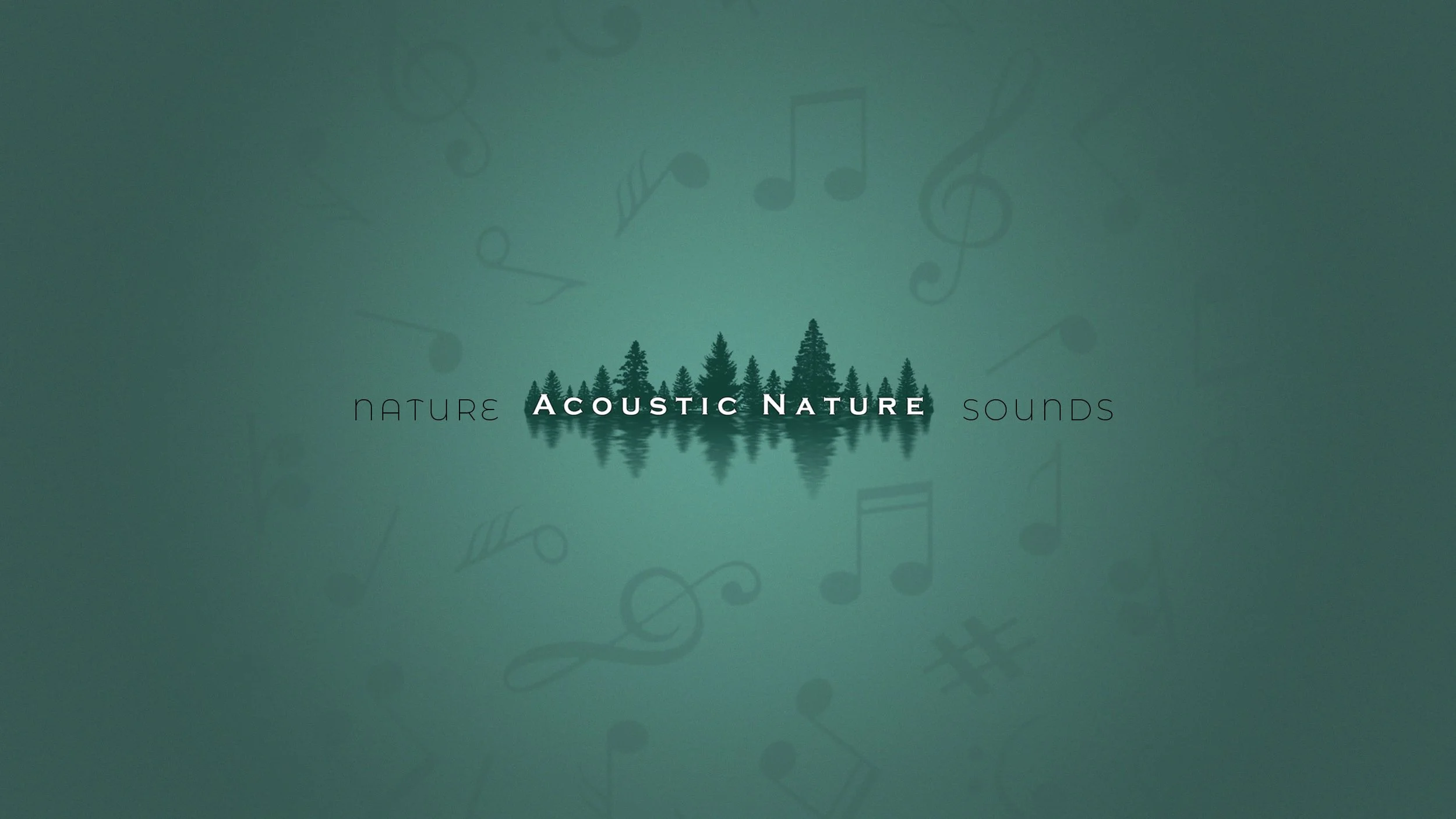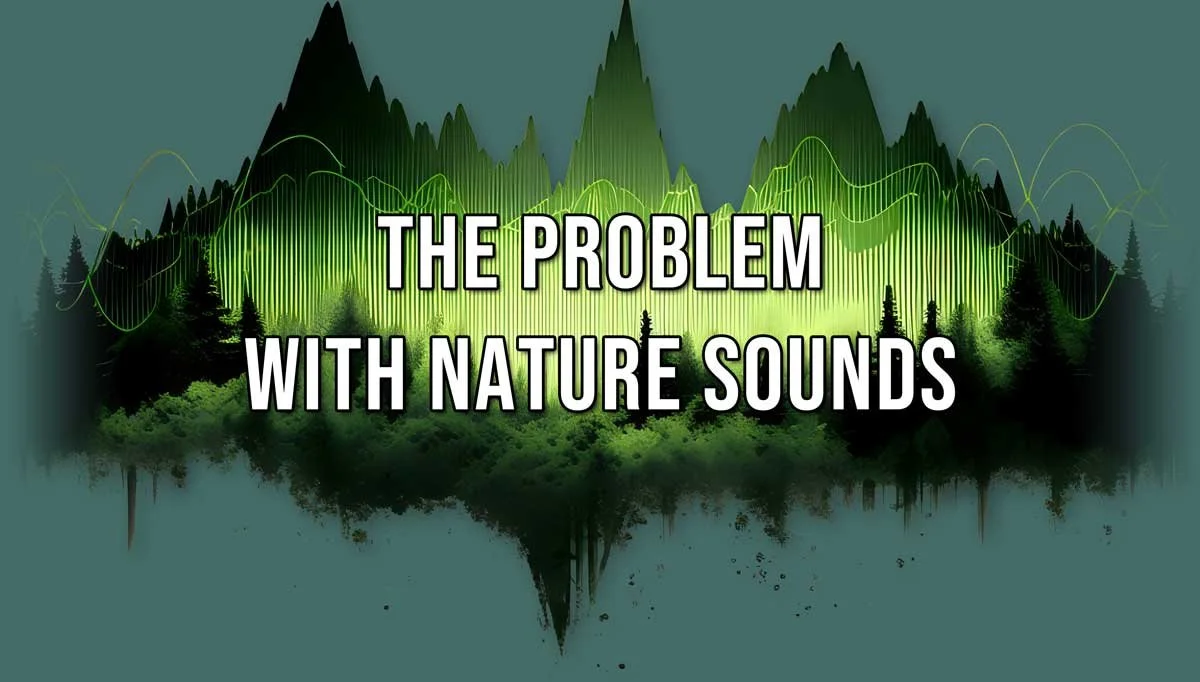
Best Nature Sounds for Sleep on YouTube
Never miss an update, Subscribe on YouTube
New videos every week!
Did you know that most nature sound videos on YouTube are exactly the same?
With global stress at an all-time high, countless people are searching for nature sounds to help relax.
This need has inspired content creators from around the world to begin producing “nature sounds” videos.
However, most don’t actually record their own sounds!
Instead, they download or purchase their sounds from sound licensing agencies.
At present, the YouTube copyright algorithm cannot distinguish between nature sounds due to their complexity.
So when you search for “rain sounds for sleep”, the results are all the same recording, just with different thumbnails.
Acoustic Nature changes that.
My name is Jared Blake. I’m the founder of Acoustic Nature.
I have been professionally recording nature sounds since 2019 and have been involved with sound design since 2011.
My sounds have been used in films, TV shows, and documentaries.
In 2022, I was featured on an episode of “America Outdoors,” produced by PBS.
One of my goals at Acoustic Nature is to bring high-quality nature sounds to anyone in need.
To achieve this goal, my nature sound albums are available on BandCamp for “name your price”, and many of my best recordings are available for free on YouTube.
I believe in the healing power of nature sounds and want to help others connect with nature through sound.
By learning how to listen, we become:
aware of the present moment
creatively inspired
motivated to live healthier and make better decisions
“Nature is calling, it’s time we listened.”
True Wilderness
Recorded in deep, remote wilderness.
Best Microphones
Recorded with the best mics in the world.
3D Sound
Binaural recordings for 3D soundscape.
The process of finding and recording my nature sounds requires hours of research, many miles traveled, and several nights spent camping in the wilderness.
To find locations without any noise of people, cars, or aircraft, I reference topographic, light pollution, and noise pollution maps.
Once I arrive, I usually must hike 5 miles deep into the woods, and then spend 2-3 days and nights exploring and recording the landscape.
Carrying all of my sound recording gear, along with backpacking supplies is not easy, but absolutely worth it when true natural silence is discovered.
In order to capture nature’s sounds to the best of my ability, I use a stereo pair of the lowest self-noise microphones in the world; Lewitt 540 SubZeros.
Because nature sounds are very quiet (often 30 dB or less), using low-noise microphones is essential to avoid any digital noise being added to the recording.
Recordings of quiet sounds made with high self-noise microphones have a distracting, high-pitched hissing sound in the background that sounds similar to white noise.
To further improve the quality of my recordings, I use the Lewitt 540 SubZero mics in a custom binaural array that simulates a human head.
By copying the shape and ear spacing of a human head, the resulting recordings have a 3D effect.
If you close your eyes, you’ll feel like you’re really there, with sounds emanating in front, to the sides, and behind you.
Best Nature Sounds for Sleep FAQ
-
The most relaxing sound to fall asleep to can vary depending on personal preference, but there are a few sounds that are commonly considered soothing:
White noise: This is a consistent, low-level sound that can help drown out other noises and create a calming environment. Examples of white noise include the sound of a fan or a static sound.
Nature sounds: Sounds of nature, such as gentle rain, ocean waves, or chirping birds, can be very relaxing and create a peaceful atmosphere.
Soft instrumental music: Slow, calming music, such as classical or instrumental pieces, can help soothe the mind and body and promote relaxation.
ASMR: Autonomous Sensory Meridian Response (ASMR) is a phenomenon where certain sounds or sensations create a tingling sensation in the body. Common ASMR triggers include whispering, tapping, and brushing sounds.
Ultimately, the most relaxing sound to fall asleep to is subjective, and what works for one person may not work for another. It's important to experiment and find what sounds work best for you.
-
Yes, nature sounds can be good for sleep as they can help create a peaceful and calming environment.
Studies have shown that listening to nature sounds, such as the sound of rain or waves, can help reduce stress and promote relaxation, which in turn can help improve the quality of sleep.
In fact, a study published in the Journal of the Association of Nurses in AIDS Care found that patients who listened to nature sounds before sleep reported improved sleep quality and decreased sleep disturbances.
However, it's important to note that the effectiveness of nature sounds for sleep can vary from person to person.
Some people may find that other types of sounds, such as white noise or soft instrumental music, work better for them.
It's important to experiment and find what works best for your individual needs and preferences.
-
The best nature sounds for sleep can vary from person to person, as different sounds may have different effects on each individual.
However, here are some of the most commonly recommended nature sounds for sleep:
Rain: The sound of gentle rain can be very calming and create a peaceful atmosphere that is conducive to sleep. It can also help mask other distracting noises.
Ocean waves: The rhythmic sound of waves can be very soothing and promote relaxation, which can help improve the quality of sleep.
Forest sounds: The sounds of birds chirping, leaves rustling, and gentle streams can create a serene environment that is conducive to sleep.
White noise with nature sounds: Combining nature sounds with white noise, such as the sound of a fan or air conditioner, can help mask other distracting noises and create a consistent, calming background sound.
Ultimately, the best nature sounds for sleep is the one that works best for you and helps you feel relaxed and calm.
-
Different people find different nature sounds to be most relaxing.
However, here are some of the most commonly cited nature sounds that are considered relaxing:
Birdsong: The sounds of birds chirping can be very calming and soothing, and can create a peaceful and serene atmosphere.
Water sounds: The sound of water flowing or gentle waves lapping against the shore can have a very calming effect, and can help reduce stress and promote relaxation.
Wind chimes: The gentle sound of wind chimes can create a relaxing and peaceful atmosphere, and can also help mask other distracting noises.
Forest sounds: The sounds of leaves rustling, birds singing, and insects chirping can create a serene and calming environment that can help reduce stress and promote relaxation.
-
Yes, nature sounds can help reduce stress.
Studies have shown that listening to nature sounds, such as the sound of a flowing stream, birds singing, or gentle rain, can help lower levels of the stress hormone cortisol in the body.
This can lead to a feeling of relaxation and calmness, which can help reduce stress and anxiety.
In fact, a study published in the Journal of Environmental Psychology found that participants who listened to nature sounds experienced greater relaxation and decreased levels of stress compared to those who listened to urban sounds.
Additionally, exposure to nature has been shown to have a positive effect on mental health and well-being, including reducing symptoms of depression and anxiety.
This suggests that listening to nature sounds may be a simple and effective way to promote relaxation and reduce stress.
Healing Power of Nature Sounds
For hundreds of years, we’ve known that nature is a treasure trove of healing medicines; whether it be medicinal compounds found in plants, boosted vitamin D levels from sunlight exposure, or faster healing when just looking at nature.
However, the healing powers of nature’s sounds are only just becoming fully realized.
Recent studies have shown that listening to pure nature sounds can help decrease stress and anxiety; symptoms of modern life that have become all too common.
So why are we so stressed out and anxious?
While some pin it on the “need it done yesterday” mentality and the ferocious work pace expected by most employers, I believe our societal soundscapes are more to blame.
As of 2021, every day in the United States is filled with the noise of 39,000 domestic airline flights, 3.7 million construction sites, and 170 million vehicles.
We’ve reached the point where living a quiet life is almost impossible.
Noise pervades every aspect of our lives, whether it’s construction outside our door, our daily commute to work, our workplaces themselves, or jets and airplanes flying overhead while we sleep.
Wherever we go, noise seems to follow.
Recent studies have shown that exposure to our noisy societal soundscapes can cause:
sleep disturbance
increased heart rate
increased cortisol (stress) levels
increased anxiety
feelings of depression
hypertension
hearing loss
What is really eye-opening about these studies is that it doesn’t take a very loud noise or long exposure to experience these negative effects.
A 2019 study found that aircraft flying over homes at night at just 50 decibels, caused a substantial increase in participant heart rates, blood pressure, and hormone levels linked to stress.
To put this into perspective, 50 dB is equivalent to a quiet conversation, a quiet suburb, a quiet office, or a quiet refrigerator.
Most of us are subjected to sounds much louder than this during our daily lives, and if you live close to an airport, you may never get a break.
In contrast to our loud modern environments, the average natural ambience is around 30 dB, equivalent to a quiet library, rustling leaves, and whispering at a distance of 5 feet (1.5 meters).
It is in these quiet places that nature’s finest sonic tonics exist.
Studies have shown that listening to pure nature sounds for only 4 minutes can:
decrease stress
decrease depression
decrease anxiety
decrease heart rate
decrease blood pressure
decrease rumination (thinking about the same thing over and over)
activate the parasympathetic nervous system (our body’s “rest and digest” mode)
So if you’re struggling with symptoms associated with modern life, please consider listening to my nature sounds for depression and anxiety relief at the beginning and end of your day.
Have a question or comment? Send me an email through the contact page.
Natural Medicine Beyond Sound
Nature is an incredible resource that offers numerous health and healing benefits.
From the air we breathe to the food we eat and the environments we inhabit, nature plays an essential role in supporting our physical, mental, and emotional well-being.
In this section, we will explore the many medicinal and natural healing benefits of nature, including the science behind them, and how to incorporate these benefits into our daily lives.
The Healing Power of Forests
Forests are often referred to as the lungs of the planet due to their ability to absorb carbon dioxide and produce oxygen. However, forests also provide a range of health benefits for humans, including stress reduction, relief from depression and anxiety, improved cognitive function, and immune system support.
Studies have shown that spending time in nature, particularly in forests, can reduce stress, depression, and anxiety levels, lower blood pressure and heart rate, and improve mood and overall well-being.
One study found that participants who spent just 15 minutes walking in a forest experienced a 16% decrease in cortisol levels, a hormone associated with stress.
Forests also offer cognitive benefits, particularly for children. Studies have shown that exposure to nature can improve attention, memory, and problem-solving skills, particularly in children with attention deficit hyperactivity disorder (ADHD).
A study conducted in 2008 found that children who spent time in natural environments had lower levels of inattention and hyperactivity compared to those who spent time in built environments.
Finally, forests are also a natural source of immune system support.
Trees produce phytoncides, which are essential oils that protect them from disease and insect attacks. These oils are also beneficial to humans and can boost immune system function, reduce inflammation, and even increase natural killer cells, which are cells that help fight infections and cancer.
The Benefits of Fresh Air
Fresh air is a fundamental component of nature and is essential for our health and well-being.
The air we breathe is made up of oxygen, nitrogen, and other gases, which are essential for our bodies to function correctly. However, many of us spend most of our time indoors, which can lead to poor air quality and health problems such as headaches, dizziness, and fatigue.
Spending time outdoors and breathing fresh air can improve our lung function, boost our immune system, and even improve our mental health.
Fresh air contains negative ions, which are molecules that have an extra electron. Negative ions are believed to have a positive effect on mood and mental health and are found in high concentrations in natural environments such as mountains, waterfalls, and forests.
Additionally, fresh air can also improve our sleep quality.
Exposure to natural light and fresh air during the day can help regulate our circadian rhythm, which is our body's internal clock that regulates sleep-wake cycles.
Studies have shown that individuals who spend more time outdoors tend to have better sleep quality and feel more alert during the day.
The Healing Power of Water
Water is essential for life, and spending time near bodies of water can have numerous health benefits. The sound of water, whether it be a gentle stream or crashing waves, can have a calming effect on the mind and body, reducing stress, depression, and anxiety levels, and promoting relaxation.
Additionally, water-based activities such as swimming, kayaking, and paddleboarding can provide a low-impact workout that is gentle on the joints while still improving cardiovascular health and muscle tone. Water also has a cooling effect on the body, making it an excellent resource for cooling down on hot days.
Finally, water can also be a natural source of therapy.
Hydrotherapy, also known as water therapy, involves the use of water to treat physical and mental health conditions. Hydrotherapy has been used for thousands of years and can help alleviate symptoms of conditions such as arthritis, fibromyalgia, and chronic pain.
The Benefits of Sunlight
Sunlight is essential for our health and well-being.
Exposure to sunlight helps our bodies produce vitamin D, a vital nutrient that helps us absorb calcium and maintain healthy bones.
Sunlight also has a positive effect on our mood and mental health, particularly during the winter months when sunlight is scarce. Seasonal affective disorder (SAD) is a type of depression that is related to changes in seasons and is often treated with light therapy, which involves exposure to bright light that mimics natural sunlight.
However, it is important to practice safe sun exposure to avoid harmful effects such as sunburn and skin damage. The American Academy of Dermatology recommends wearing protective clothing and sunscreen with an SPF of at least 30 when spending time outdoors.
The Benefits of Earthing
Earthing, also known as grounding, is the practice of connecting with the earth's natural energy by walking barefoot or using conductive materials such as grounding mats or blankets. Proponents of earthing claim that it can reduce inflammation, improve sleep quality, and even boost mood and energy levels.
There is some scientific evidence to support the benefits of earthing. Studies have shown that earthing can reduce levels of inflammation and pain, and even improve heart health by reducing blood viscosity and improving blood flow.
However, more research is needed to fully understand the benefits of earthing and how it works. It is also important to note that some individuals, particularly those with certain medical conditions, should not practice earthing without consulting with a healthcare professional first.
Incorporating Nature into Daily Life
Incorporating nature into our daily lives can be as simple as taking a walk in a park or spending time in a backyard garden. Here are some additional ways to incorporate nature into your daily routine:
Take a hike or go for a walk in a nearby park or nature reserve.
Practice yoga or meditation outdoors.
Plant a garden or tend to indoor plants.
Take a swim or participate in water-based activities.
Open windows to let in fresh air and natural light.
Spend time in a nearby forest or natural area.
Practice earthing by walking barefoot on grass or soil.
Take breaks throughout the day to step outside and breathe fresh air.















